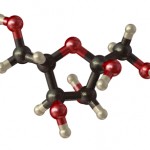In my last post I said I'd dig more fully into the background and safety record of the artificial sweeteners. Then I got diverted; one question was what kind of sugars were there before the artificial sort? I ended up at a website called Lab Cat which, in a brief verbal and visual format, described the sugars we commonly might ingest. Table sugar usually comes from either sugarcane or beets; it's a combination of two other sugars, glucose and fructose, the former found, typically in grapes and corn; the latter in honey, fruits and vegetables.
When a physician measures your blood sugar level; he or she is checking for glucose. The WebMD site has a nice discussion of blood sugar, mainly focused on those who have too much of it, namely diabetics. Another brief discussion, this one by a Harvard Medical School professor, can be found in an abcNEWS piece online. Normal fasting blood sugar levels are in the 70 to 99 milligrams per deciliter (mg/dl) range. A deciliter is one-tenth of a liter, a little over three and a third ounces or six and two-thirds tablespoons. A liter is 1.05 quarts and a liter of water has 33.81 ounces of water. Even after eating, a non-diabetic person doesn't usually have a blood sugar level over 135 to 140 mg/dl.
Diabetics may have considerably higher blood sugar levels, enough so their urine contains sugar. Up to levels of 180-200 mg/dl your kidneys can reabsorb sugar; above those levels a urine dipstick test will be positive (briefly immersing a plastic strip into the urine; the chemicals on the strip will cause a color change if glucose is present in the urine).
If your blood sugar is low, below the low 70 mg/dl level, either from missing meals or overdosing with insulin or oral drugs used for diabetes (there are a host of other causes), you usually will feel shaky, hungry and perhaps have other symptoms. Most of us who are otherwise healthy are unlikely to have our blood sugar level fall to really low levels, but those can be extremely dangerous.
If you get an IV with sugar, it's really glucose under its pseudonym, dextrose. A common IV solution is D5W; that means the composition of the fluid is 5% dextrose (glucose) dissolved in water. another is D5NS, meaning the sugar is dissolved in a salt solution. That is usually given to patients who are dehydrated and need volume; the sugar, in the form of dextrose, is added to make the sterile intravenous fluid "isotonic," An isotonic solution has the same salt concentration as the normal cells of the body and the blood.(using only salt enough to approximately match what your normal blood level of sodium should be and not adding the dextrose would result in a fluid too dilute for safety).
When I read what I had written thus far I realized I wasn't sure anymore what exactly happens to the fructose part of table sugar, or for that matter the high-fructose corn syrup added to so many processed foods. That turns out to be more complicated than I remembered so I'll save that discussion for my next post.



